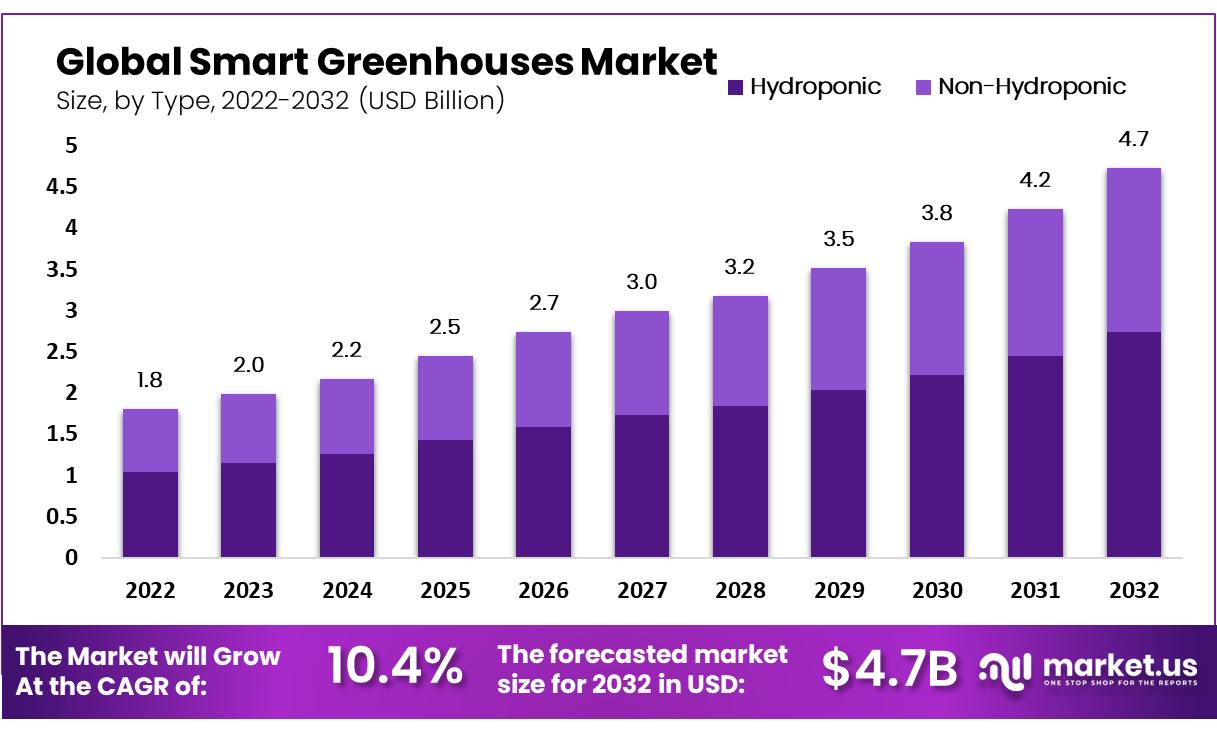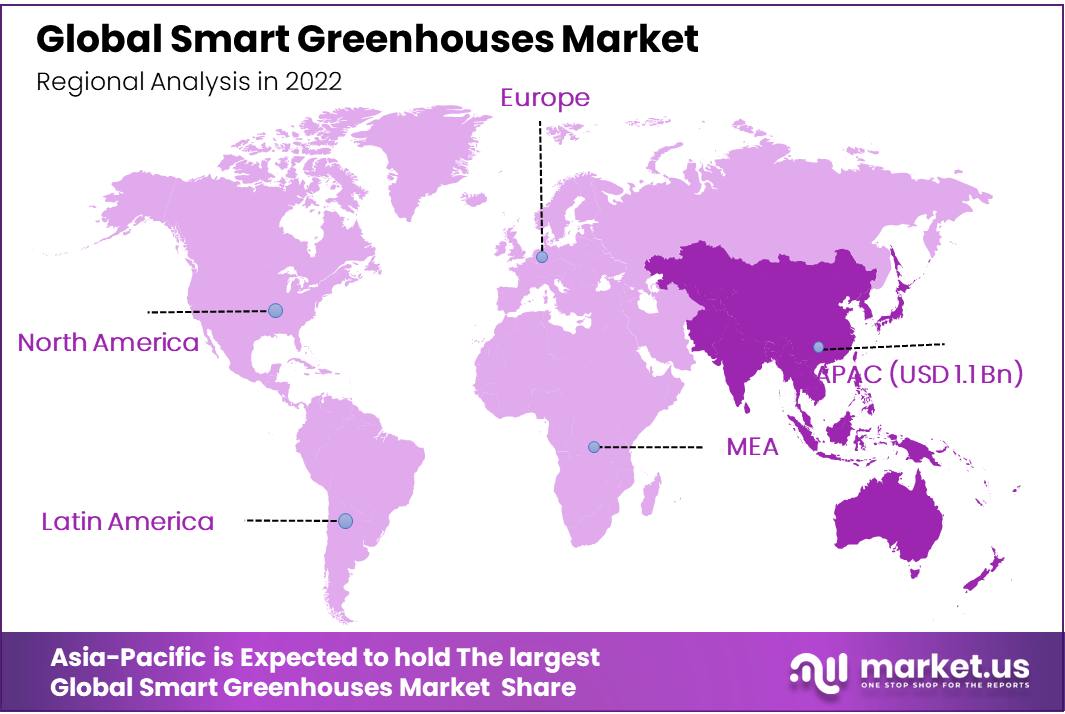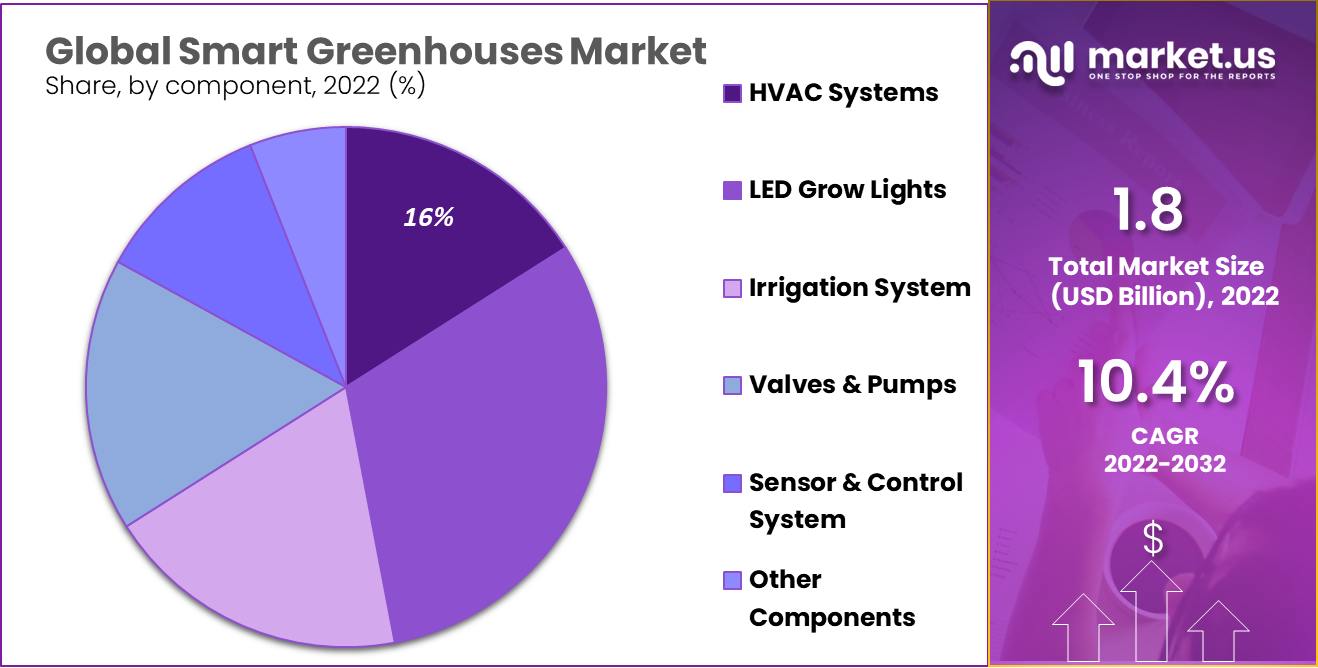New York, Oct. 03, 2023 (GLOBE NEWSWIRE) -- According to the Market.us report, the Smart Greenhouses Market size was USD 1.8 billion in 2022 and is projected to surpass around USD 4.7 billion by 2032, it is poised to reach a registered CAGR of 10.4% from 2023 to 2032.
Smart greenhouses are advanced agricultural facilities that optimize plant growth and reduce resource consumption while minimizing environmental impact. They use sensors to measure temperature, humidity, light, and soil moisture, and automated systems regulate climate, irrigation, and nutrient delivery. The market has grown due to growing demand for fresh produce and sustainable practices.

Get deeper insights into the market size, current market scenario, future growth opportunities, major growth driving factors, the latest trends, and much more. Buy the full report here
Key Takeaway:
- By type, in 2022, the smart greenhouses market was dominated by the Hydroponic segment due to its increased usage.
- By component, the LED Grow Lights segment dominated the largest market share in the smart greenhouses market in 2022.
- By end-user, the Research and educational segment dominated the largest market share.
- In 2022, Asia-Pacific dominated the market with the highest revenue share of 60%.
- Europe is anticipated to have the highest CAGR among all the regions.
Factors affecting the growth of the Smart Greenhouses industry
- Increasing Global Population: The world's population is steadily rising, increasing the demand for fresh produce. Smart Greenhouses enable year-round cultivation and higher crop yields, making them essential for meeting this growing demand.
- Technological Advancements: Rapid advancements in sensor technology, automation, and data analytics have made Smart Greenhouses more accessible and cost-effective. This drives adoption among growers seeking to improve their yields and operational efficiency.
- Climate Change and Weather Variability: Unpredictable weather patterns due to climate change pose significant risks to traditional agriculture. Smart Greenhouses offer climate-controlled environments, mitigating these risks and ensuring stable crop production.
- High Initial Costs: Setting up a Smart Greenhouse can require a significant upfront investment in infrastructure, technology, and automation systems. This can be a deterrent for smaller growers.
- Operational Complexity: Managing Smart Greenhouses can be complex, requiring technical expertise in automation and data analysis. This can be a barrier for traditional farmers transitioning to smart agriculture.
Market Growth
The Global Smart Greenhouses market has grown significantly due to the increasing demand for sustainable agriculture, technological advancements, and lessons learned from the COVID-19 pandemic. Smart greenhouses optimize crop cultivation through automation, monitoring, and control systems, reducing resource wastage and improving crop quality. The market is democratized by technological advancements, making them accessible to a wider range of farmers, including small-scale farmers. Government initiatives and incentives further fuel market growth. The market is expected to expand further, offering innovative solutions to meet global food needs while minimizing environmental impact.
Regional Analysis
With a market share of 60%, Asia-Pacific is the most profitable region in the worldwide market for smart greenhouses. The dominance of the Asia-Pacific (APAC) region in the global Smart Greenhouses market is due to several key factors. These include a rapidly growing population in countries like China and India, driving demand for sustainable agriculture practices. Environmental challenges like air pollution and water scarcity have made smart greenhouse technologies a practical solution. Favorable government policies and incentives in APAC countries encourage adoption, creating a favorable business environment. Additionally, APAC's robust manufacturing ecosystem ensures cost-effective components and skilled labor, further enhancing its dominance in the global Smart Greenhouses market.

The report analyses the market size and growth and provides accurate predictions on the growth of the market. View FREE PDF Sample
Competitive Landscape
Leaders in the global smart greenhouses market are focusing on technological innovation, incorporating advanced sensors and automation systems to optimize crop growth and resource management. Others are expanding their market presence through strategic partnerships and collaborations, tapping into new regions and customer segments. Additionally, cost-effective manufacturing and pricing strategies are being employed to attract a broader customer base.
Some of the major players include:
- Heliospectra AB
- Rough Brothers Inc. (Gibraltar Industries INC.)
- Lumigrow Inc.
- Certhon
- GreenTech Agro LLC
- Argus Control System Ltd
- Hort Americans
- Greenhouse Megastore (BFG Supply)
- Netafim
- Desert Growing
- Sensaphone
- CarbonBook (Motorleaf)
- Other Key Players
Scope of the Report
| Report Attributes | Details |
| Market Value (2022) | USD 1.8 Billion |
| Forecast Revenue 2032 | USD 4.7 Billion |
| CAGR (2023 to 2032) | 10.4% |
| Asia-Pacific Revenue Share | 60% |
| Base Year | 2022 |
| Historic Period | 2016 to 2022 |
| Forecast Year | 2023 to 2032 |
Market Drivers
The global Smart Greenhouses market is experiencing strong growth due to several driving factors. These include the rising demand for sustainable agriculture and the need to optimize crop yields in response to climate change. Integration of advanced automation like IoT sensors and AI monitoring is boosting crop management accuracy and cutting operational costs. Government incentives and increased awareness of resource conservation are further expanding the market. Smart greenhouses are gaining popularity for their ability to protect crops from adverse weather and pests. Energy-efficient technologies are also reducing greenhouse carbon footprints. Urban population growth and a desire for locally sourced produce are creating profitable opportunities. Ongoing R&D to improve technology accessibility to smaller-scale farmers is expected to sustain market growth.
Market Restraints
The Global Smart Greenhouses market faces several notable restraints. Firstly, the high initial setup costs associated with smart greenhouse technology, including sensors, automation systems, and climate control, can be a significant barrier for potential adopters. Additionally, the complexity of integrating and maintaining these systems can deter some growers. Moreover, the reliance on electricity and technology makes smart greenhouses vulnerable to power outages and cybersecurity threats. Regulatory challenges related to environmental regulations and zoning restrictions can also limit the expansion of smart greenhouse facilities. Lastly, the learning curve for operators and the need for skilled personnel can impede the widespread adoption of smart greenhouse technology.
Market Opportunities
The integration of IoT and AI technologies in the global smart greenhouse market offers promising opportunities. These technologies enable the creation of optimized conditions for crops by analyzing historical data and adjusting various parameters automatically. For example, when AI systems detect specific crop needs like higher humidity levels, they can activate appropriate systems without constant human intervention. Additionally, IoT and AI enhance resource efficiency by monitoring and controlling water and energy usage, reducing waste and operational costs. They also improve pest and disease management through early detection and alerts, reducing crop losses and the reliance on pesticides. In essence, IoT and AI revolutionize greenhouse farming by automating tasks, conserving resources, and improving crop health.
Request for Customization @ https://market.us/book-appointment/?report_id=106884
Report Segmentation of the Smart Greenhouses Market
Type Insight
By type, the hydroponics segment dominated the global smart greenhouses market with a market share of 58%. Hydroponic systems provide meticulous control over nutrient distribution to plants, resulting in amplified yields and accelerated growth when contrasted with conventional soil-based approaches. This heightened efficiency not only boosts output but also curtails resource consumption, thereby positioning hydroponic greenhouses as a more sustainable alternative. Moreover, hydroponic setups facilitate year-round cultivation, nullifying the limitations imposed by seasonal fluctuations. Furthermore, their advanced automation capabilities drastically reduce the dependence on manual labor, subsequently slashing operational expenditures.
Component Insight
By component, the LED Grow Lights category dominated the global smart greenhouses market with a market share of 31%. LED Grow Lights have taken the lead in the global Smart Greenhouses sector due to their remarkable efficiency in enhancing plant growth. They provide growers with precise control over light intensity and spectrum, enabling customization for different crops. Additionally, LED Grow Lights are highly energy-efficient, reducing operational expenses and environmental effects. Their durability and extended lifespan also contribute to cost-effectiveness. As agriculture trends toward sustainability and resource conservation, LED Grow Lights have become the preferred option for greenhouse cultivation, solidifying their dominance in the market.

End User Insight
By end-user, the research & educational institutes segment dominated the global smart greenhouses market with a market share of 32.5%. These institutions play a pivotal role in advancing agricultural research and technology, making them early adopters of smart greenhouse solutions to conduct experiments and develop sustainable farming practices. Additionally, their need for controlled environments for botanical studies, crop research, and educational purposes drives the demand for smart greenhouse technology. Moreover, the continuous influx of government funding for research initiatives in these institutions further fuels their capacity to invest in cutting-edge greenhouse technologies.
Market Segmentation
Based on Type
- Hydroponic
- Non-Hydroponic
Based on Component
- HVAC Systems
- LED Grow Lights
- Irrigation System
- Valves & Pumps
- Sensor & Control System
- Other Components
Based on End User
- Commercial Growers
- Research & Educational Institutes
- Retail Gardens
- Other End-Users
By Geography
- North America
- The US
- Canada
- Europe
- Germany
- France
- The UK
- Spain
- Italy
- Russia & CIS
- Rest of Europe
- APAC
- China
- Japan
- South Korea
- India
- ASEAN
- Rest of APAC
- Latin America
- Brazil
- Mexico
- Rest of Latin America
- Middle East & Africa
- GCC
- South Africa
- Rest of MEA
Recent Development of the Smart Greenhouses Market
- In Jan 2023, Dutch greenhouse construction company Bosman Van Zaal declared the completion of their high-tech greenhouse in Russia, which will be used to grow strawberries year-round.
- In Feb 2023, Japanese firm Kubo Group revealed plans to construct a similar high-tech greenhouse in Japan that will supply vegetables for the local market.
Extensive Coverage on Agriculture and Agri Products:
- Greenhouse Soil Market is projected to be US$ 3,915.1 Mn in 2019 to reach US$ 5,868.2 Mn by 2029 at a CAGR of 4.2%.
- Vertical Farming Market size is expected to be worth around USD 35.3 Billion by 2032 from USD 5.6 Billion in 2022, growing at a CAGR of 20.80% during the forecast period from 2023 to 2032.
- Silico Manganese Market size is expected to be worth around USD 40.05 Bn by 2032 from USD 23.76 Bn in 2022, growing at a CAGR of 5.5% during the forecast period from 2022 to 2032.
- Green Hydrogen Market size is expected to be worth around USD 62.9 Billion by 2032 from USD 0.7 Billion in 2022, growing at a CAGR of 58.6% during the forecast period 2022 to 2032.
- Drilling Fluids Market accounted for USD 9.8 billion. This market is estimated to reach USD 16.1 billion in 2032 at a CAGR of 5.2% between 2023 and 2032.
- Controlled Environment Agriculture Market size is expected to be worth around USD 377.6 billion by 2032 from USD 74.4 billion in 2022, growing at a CAGR of 18.13% during the forecast period 2022 to 2032.
- Insect Protein Market size is expected to be worth around USD 3,715.0 Million by 2032 from USD 267.6 Million in 2022, growing at a CAGR of 31.10% during the forecast period from 2023 to 2032.
- Commercial Greenhouse Market was valued at USD 34.5 billion. This market is estimated to reach USD 95.4 billion in 2032 at a CAGR of 11% between 2023 and 2032.
- Hops Market size is expected to be worth around USD 49.9 Billion by 2032 from USD 33.1 Billion in 2022, growing at a CAGR of 4.20% during the forecast period from 2023 to 2032.
- Regenerative Agriculture Market was valued at USD 8.8 billion and is predicted to reach USD 31.6 billion by 2032. Between 2023 and 2032, this market is estimated to register a CAGR of 14%.
- Bee Vectoring Technologies Market was valued at USD 21.3 billion. This market is estimated to reach USD 34.7 billion in 2032 at a CAGR of 5.14% between 2023 and 2032.
- Smart Farming Market accounted for USD 19.5 billion and is expected to reach USD 53 billion in 2032. This market is estimated to register the highest CAGR of 10.5% between 2023 and 2032.
- Laser Scarecrows Market was valued at USD 340.2 million. This market is estimated to reach USD 573 million in 2032 a CAGR of 5.5% between 2023 and 2032.
- Mushroom Market was worth USD 56 billion. It is estimated to reach USD 136 billion in 2032 growing at a CAGR of 9.5% between 2023-2032.
About Us
Market.US (Powered by Prudour Pvt Ltd) specializes in in-depth market research and analysis and has been proving its mettle as a consulting and customized market research company, apart from being a much sought-after syndicated market research report-providing firm. Market.US provides customization to suit any specific or unique requirement and tailor-makes reports as per request. We go beyond boundaries to take analytics, analysis, study, and outlook to newer heights and broader horizons.
Follow Us On LinkedIn Facebook Twitter
Our Blog:
More Category-Wise Reports
- Chemicals & Materials Market Research Reports
- Food and Beverage Market Research Reports
- Energy and Power Market Research Reports
- Building and Construction Market Research Reports
